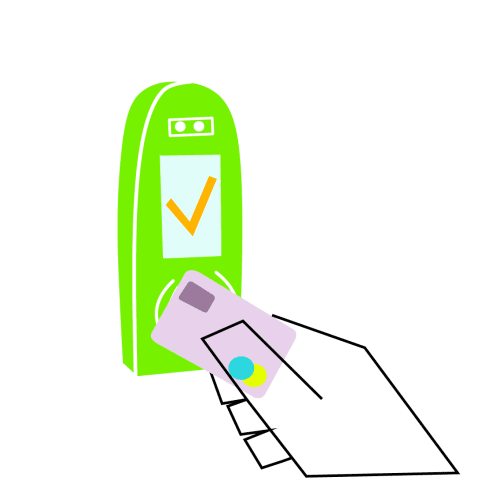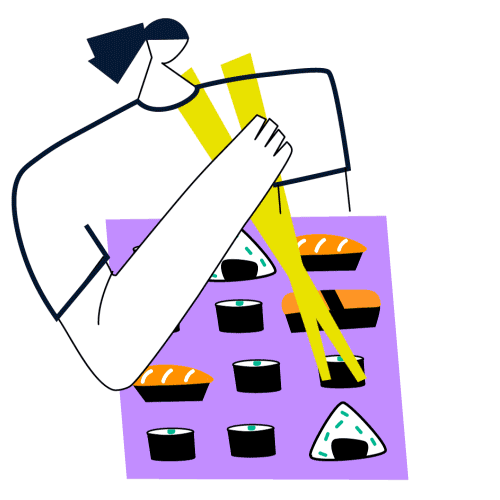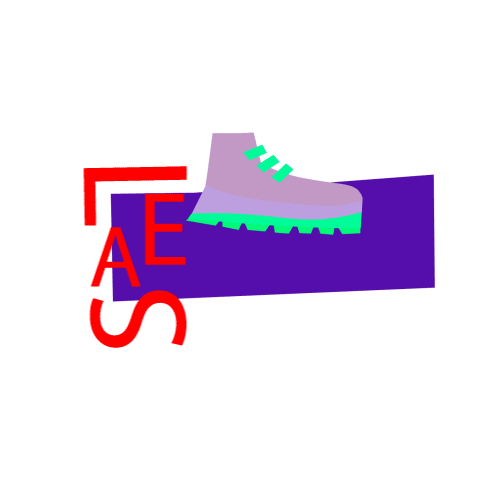Sandwiched: how geopolitics determined the economic development of Armenia and Georgia
Armenia and Georgia are small Caucasian countries, sandwiched between the interests of Russia and other major Western powers, as they are located on the East-West trade intersection.
On the way to independence, these countries have passed through different economic and geopolitical models of development, but the quality of life of citizens hasn’t become significantly better or worse, depending on the chosen direction. This is evidenced by the flows of foreign investment, the trade relations of Georgia and Armenia with other countries, the values of GDP per capita, poverty indices, external debt, etc.
A week in the life of a Georgian and an Armenian
We have projected one week of George’s life in Tbilisi and Lilith’s in Yerevan to tell about the average standard of living of citizens of both countries. All data are taken from the state statistical committees of Georgia and Armenia, as well as from Numbeo, the world’s largest cost of living database.






Making approximately the same purchases in one week, George spent 571 lari ($181), which is 48% of his salary, and Lilith spent 99 700 drams ($209), which is 52% of her salary.
Now let’s look at what political and economic direction the countries of George and Lilith took since the dissolution of the Soviet Union and analyze some important economic indicators.
Armenia and Georgia's paths to independence: through Russia or the West?
It’s obvious that for Armenia and Georgia one of the key components of economic development is their international relations – both with their immediate geographical neighbors and with the countries that determine the main directions of world politics. Since gaining independence, Armenia has been trying to balance relations between Russia and the West, as for Georgia, after Mikheil Saakashvili came to power, the country adheres to a clearly pro-Western policy. This is evidenced by facts and data.
Facts
After the dissolution of the Soviet Union, the Commonwealth of Independent States (CIS) was created in the post-Soviet space in order to ensure economic ties between the countries of the former Soviet Union, which were part of the same economic system during the Soviet Union.
Armenia accepted the agreement on the establishment of the CIS and joined the Union in 1991. At the moment, the Republic of Armenia is still a member of the CIS.
Georgia joined the CIS a little later, in 1993, but left it in August 2008. According to the statement of the Georgian Foreign Ministry, the main reason for leaving the CIS was Russia’s “military aggression” against Georgia.
The Collective Security Treaty Organization (CSTO) was established by Russia in 1992. Armenia and Georgia joined the CSTO in 1994, but Georgia left the CSTO in 1999.
In 2013, Armenia confirmed the vector of its development, giving priority to the Eurasian direction. On September 3, 2013, following the talks between Vladimir Putin and Serzh Sargsyan, the intention of the Republic of Armenia to join the Customs Union and subsequently participate in the formation of the Eurasian Economic Union was announced.
Data. Foreign investments
In the flows of foreign investments to Armenia over the past two decades, there is a clear dominance of investments from Russia to Armenia. The largest amount of Russian investments ($714 million) was in 2008 and amounts 71% of all investments. This is the year when the third President of Armenia, Serzh Sargsyan, came to power in Armenia. Unlike his predecessor Robert Kocharyan, Serzh Sargsyan tried to pursue a complementary policy and balance relations with Russia and the West. Despite the dominance of investments from Russia, investments from the European Union to Armenia also increased from 2009 to 2011.
It should be noted that after the presidential elections in February 2008, which were won by the then Prime Minister Serzh Sargsyan, the opposition forces didn’t recognize the results of the elections. Thousands of demonstrations took place in Yerevan at the end of February, but there was no change of power. On March 1, the authorities violently dispersed the protests, resulting in the death of 10 people.
It’s different in Georgia. In general, the list of countries actively investing in Georgia is much wider: in addition to the US and the European Union, Great Britain also invests. The data indicates a trend of investment growth from the UK, the Netherlands and Turkey. At the same time, investments from Russia for the entire period averaged 5% of all investments.
The data show that since 2003, when Mikheil Saakashvili came to power and turned the vector of development towards the West, the growth rate of foreign investment in Georgia began to noticeably increase.
In general, foreign investment is an important part of the economic development of the post-Soviet countries.
The World Bank data confirms this by showing the share of foreign investment flows in the GDP of Georgia and Armenia from 1998 to 2019. The highest rate was registered in Georgia in 2007 and amounted to 18,6%. The picture of recent years shows a steady weakening of the role of foreign investment as a component of the Armenian economy. In Georgia, the situation is more stable, with a tendency to increase rather than decrease.
Data. Trade relations
Another important component of economic development is international trade relations. Let’s see which countries Armenia and Georgia cooperated with from the late 90s to 2019.
World Bank data show that Armenia steadily receives the largest export income from Russia. In 2019, the income received from exports to Russia amounted to almost $720 million, which is 27% of all exports for that year.
Mainly consumer goods, food, raw materials, etc were exported. Over the past 20 years, there has been an increase in income from exports to Switzerland, Bulgaria, China and Iraq. As of 2019, these countries occupy the top five positions in exports.
Russia is also the leading importer to Armenia. As in the case of exports, in 2019 the highest monetary indicator of imports was registered – about $1,5 billion, which is 29% of all imports.
The vast majority of imports to Armenia from Russia are gas. The jump in 2007 is probably associated with an increase in natural gas imports. According to “Gazprom Armenia”, the volume of natural gas imports to Armenia in the first half of 2007 increased by 22,15% compared to last year.
It’s different in Georgia: exports of goods to Russia began to decrease sharply in the period from 2005-2009, which is also due to the policy of Mikheil Saakashvili. Total exports of Georgia amount to about $4 billion, it exports more than 2 500 items of goods to 120 countries. The top five export partners of Georgia include Azerbaijan (13,4% of total exports), Russia (13,08%), Armenia (11,4%), Bulgaria (7,5%) and Ukraine (6,6%).
After 2009, Georgia began to increase the number of exports to Russia again, after which there was another decrease in 2015. Despite the fact that Azerbaijan, Armenia, Bulgaria and Ukraine pushed Russia down from the first position in the list of exporters, by 2019 it had again risen to second place.
Georgia’s total imports amount to more than $9 billion, it imports more than 3 900 items of goods from more than 125 countries. The top five importers of Georgia include Turkey (17% of total imports), Russia (10%), China (9%), the USA (7%) and Azerbaijan (7,8%).
The data indicates an absolute dominance of Turkish goods. In 2014, the maximum value was registered – $1,7 million, which amounted to 20% of all imports.
The decrease in imports from Russia was observed from 2007 to 2009, when the global economic crisis coincided with the end of the first and the beginning of the second presidential term of Mikheil Saakashvili, which doubly affected the amplitude of decrease.
The trade balance of Georgia and Armenia is shown below. Over the entire time period presented, these countries imported much more than they exported.
Comparing the total export/import volumes of Armenia and Georgia, we can see that from 1999 to 2003, the neighboring countries went toe-to-toe, but after 2004, the money from imports from Georgia began to grow much faster than from imports from Armenia. It’s the same with exports to these countries։ more is exported to Georgia than to Armenia.
What does the data say about the quality of life of people?
All the considered aspects indicate that Armenia and Georgia, despite all the similarities, have followed different paths of economic development. But depending on this, the standard of living of the citizens of these countries hasn’t become noticeably better or worse relative to each other.
World Bank data shows that, in general, the GDP per capita values of Georgia and Armenia increased significantly during the period after the dissolution of the Soviet Union and up to 2020, but the growth trend broke down in 2008 when the global economy was gripped by the crisis
Despite this, Georgia managed to pull the country’s economy out of the crisis over the next five years and achieve the highest GDP per capita ($4 739), while Armenia over the same period of time only returned the indicators to the level they were before the crisis. The next decrease in GDP indicators occurred in 2014, which is directly related to the financial crisis in Russia in 2014-2015. In the above-mentioned events, the correlation between the economies of the geopolitically close to each other countries is seen.
The data on the growth of GDP per capita in Armenia show that in 2009 the indicator fell by 14,1%, which was the third worst indicator in the world. Despite the fact that the decrease in Armenia was deeper, a few years later, due to the rapid growth rate of GDP per capita, the two countries almost equaled, reaching approximately $4 300.
Considering GDP per capita as one of the main indicators of the standard of living of the citizens of Armenia and Georgia, we should not forget about such indicators as economic inequality (Gini index) and the poverty index.
The Gini index is a measure of statistical dispersion intended to represent the income inequality or the wealth inequality within a nation or a social group. The more its value deviates from zero and approaches 1 (100% on the graph), the more income is concentrated in the hands of individual groups of the population and the higher the level of social inequality in the state, and vice versa. The data show that income distribution inequality in Georgia is steadily higher than income distribution inequality in Armenia.
The poverty gap index shows the percentage of people who do not earn enough to meet basic needs for appropriate human survival. The poverty gap index measures the extent of falling below the poverty line (%, share of the poverty line).
As we can see, during the years when Georgia changed the vector of its development in the pro-Western direction (2003-2011), the poverty gap index was stable at around 10%. After, the situation began to improve and over the next 4 years it reached about 4%.
The situation is different in Armenia: since 2001, the index has been gradually decreasing, reaching 2% in 2008. Until 2019, there were no strong jumps and recessions in Armenia.
The indicator of the country’s economic situation is also the volume of gross external debt, which includes not only state debt, but also external debts of the private sector. As of 2019, Armenia’s gross external debt amounted to about $5,7 billion, and Georgia’s debt amounted to about $6,4 billion.
Considering the indicators of the gross external debt of these countries, it’s necessary to take into account the volume of gross external debt per capita. The accumulated debt of Georgia is higher than the values for Armenia, despite the fact that Georgia had broader development opportunities on the way to independence (access to the sea, open borders, economic and diplomatic relations with all neighbors).
What does all this mean?
After the dissolution of the Soviet Union, the authorities of Georgia and Armenia chose different ways of economic development and settled in different geopolitical camps, but this didn’t significantly affect the quality of life of ordinary citizens.
Georgia clearly tried to pave its development way through the West, as evidenced by the presence of the overwhelming majority of foreign investment flows from the West, as well as membership in pro-Western military-economic and political alliances. Armenia, in turn, has also made attempts to strengthen its international relations with the West, but due to the closely built ties with Russia, these attempts have not achieved significant results.
Do you remember George and Lilith? Our article began with a story about their approximately equal level of income, costs and quality of life in general.
The study of socio-economic indicators gives us the right to state that their example is a good projection on the standard of living of all average residents of Georgia and Armenia.
Methodology
The main source of data for economic and social indicators of Armenia and Georgia is the World Bank. We used this resource because the methodology of data collection is the same for both countries.
We also took data on the poverty gap index from the World Bank, which has three different poverty lines. On the recommendation of Karlen Khachatryan, an expert in the field of economics, in the case of Armenia and Georgia, we chose the average $3,2 purchasing power parity (PPP) to compare the poverty level, since they both are considered middle-income countries.
Data on gross external debt and foreign investment flows are taken from the State Statistical Committees of Armenia and Georgia.
It should be noted that data for 2020 are mostly not included in the analysis, since the situation with COVID-19 in all countries has significantly worsened economic indicators.It was important for us to show the main trends in the context of the last decades.
Illustrator: Lily Petrosyan
Economist: Karlen Khachatryan
Thanks to Hranoush Dermoyan for help in developing the idea and in stage the preliminary data collection research.
The article was created in the frames of LAMPA Accelerator with support of School of Data Kyrgyzstan.
Author
Students
Milena
Barseghyan
Instructor
Instructors
Kate
Mamyan